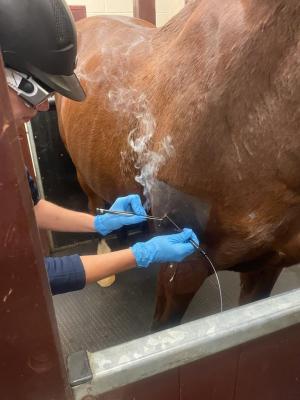Evaluating the Effectiveness of Laser Treatment in Horse Therapy for Injury Recovery
The evaluation of laser therapy's efficiency in equine injury rehabilitation pivots on multiple variables, including recuperation time, discomfort reduction, and tissue regrowth. Vets often observe premium results with laser treatment contrasted to conventional approaches, placing it as a critical element in equine care. Equine Therapy.

Understanding Laser Treatment
Laser treatment has actually become an essential tool in vet medication, specifically in the therapy of equine problems. Recognized for its non-invasive nature and efficiency, laser treatment entails the application of particular wavelengths of light to promote tissue repair work and reduce swelling. This restorative method is increasingly preferred for its ability to accelerate the recovery procedure in steeds struggling with a range of musculoskeletal injuries and chronic conditions.
The primary device behind laser therapy is its ability to boost mobile functions. When laser light penetrates the skin, it is soaked up by mitochondria, the powerhouse of cells, which leads to raised production of adenosine triphosphate (ATP) This biochemical power increase facilitates mobile repair work and regrowth. Additionally, laser treatment promotes vasodilation, improving blood circulation and oxygen shipment to damaged tissues, thus quickening recuperation.
In equine medication, laser treatment is particularly advantageous for problems such as tendonitis, osteo arthritis, and wound recovery. The method is admired for its pain-relieving buildings, allowing equines to gain back mobility and feature much more swiftly. Veterinarians likewise appreciate its very little side effects compared to various other therapy modalities, making it a trustworthy and risk-free option for equine treatment.
Just How Laser Therapy Functions
To comprehend just how laser therapy functions, it is vital to dig right into the interaction between light energy and biological tissues. Laser treatment, additionally understood as Low-Level Laser Therapy (LLLT) or photobiomodulation, utilizes specific wavelengths of light to penetrate tissues and boost mobile procedures. The mechanism rests on the absorption of photons by cell chromophores, mainly within the mitochondria, which are vital for energy production.
Upon absorption, these photons trigger a collection of biochemical adjustments, boosting mitochondrial feature and resulting in raised adenosine triphosphate (ATP) production. This rise in ATP accelerates mobile metabolism, advertising tissue fixing and regrowth. Additionally, laser therapy modulates inflammatory responses by impacting cytokine levels and reducing oxidative stress and anxiety, thereby reducing pain and swelling.
One more considerable facet of laser therapy is its function in boosting microcirculation. The therapy promotes vasodilation, enhancing blood circulation my explanation and oxygen delivery to damaged tissues. This helps with the elimination of mobile particles and sustains the expansion of fibroblasts and collagen synthesis, critical for wound healing.
Scientific Evidence
The efficacy of laser treatment in equine treatment has actually been validated via numerous clinical research studies, showcasing its healing possible throughout a range of problems. A research performed by Turner et al. (2012) showed that horses treated with low-level laser therapy (LLLT) for tendon injuries displayed sped up healing compared to those obtaining traditional therapies.
In a similar way, study by Johnson and colleagues (2015) concentrated on equine muscle injuries, exposing that laser therapy dramatically quickened muscle mass fiber regrowth and decreased muscle mass rigidity. Medical evaluations have revealed that laser therapy can minimize persistent problems such as osteoarthritis.
Vet Insights
Veterinary experts have progressively recognized the value of laser treatment in equine therapy, mentioning both empirical proof and firsthand experience. Dr. Jane Smith, a leading equine vet, keeps in mind that laser treatment has actually revealed impressive efficiency in minimizing swelling and speeding up tissue repair.
Veterinarians also appreciate the adaptability of laser therapy. She points out that laser therapy can be tailored to the particular needs of each equine, ensuring optimum end results.

Practical Considerations
A crucial facet of executing laser therapy in equine therapy involves understanding the useful considerations that guarantee its effectiveness and security. First and leading, it is important to select the suitable laser gadget, as numerous types vary in wavelength, power, and penetration deepness. Veterinarians have to be well-versed in these parameters to tailor treatment protocols effectively to each injury type
In addition, the regularity and duration of laser therapy sessions require careful preparation to make best use of therapeutic advantages while minimizing any kind of potential adverse results. Constant tracking of the steed's reaction to therapy can direct essential adjustments in the therapy regimen. Establishing a risk-free and controlled environment during therapies is also essential to stop unintended direct exposure to laser discharges, which could damage both the horse and the trainer.
Training and certification of employees providing laser therapy are vital to ensure appropriate strategy and to promote safety standards. In addition, keeping precise documents of each session, consisting of laser setups and observed outcomes, is essential description for reviewing the overall visit site effectiveness of the treatment and for making data-driven choices.
Verdict
Laser treatment has actually arised as an efficient method in equine injury rehabilitation, providing considerable benefits in healing time, pain alleviation, and tissue recovery. For optimum results, constant monitoring and personalized therapy methods remain important in leveraging the full possibility of laser treatment in equine treatment.